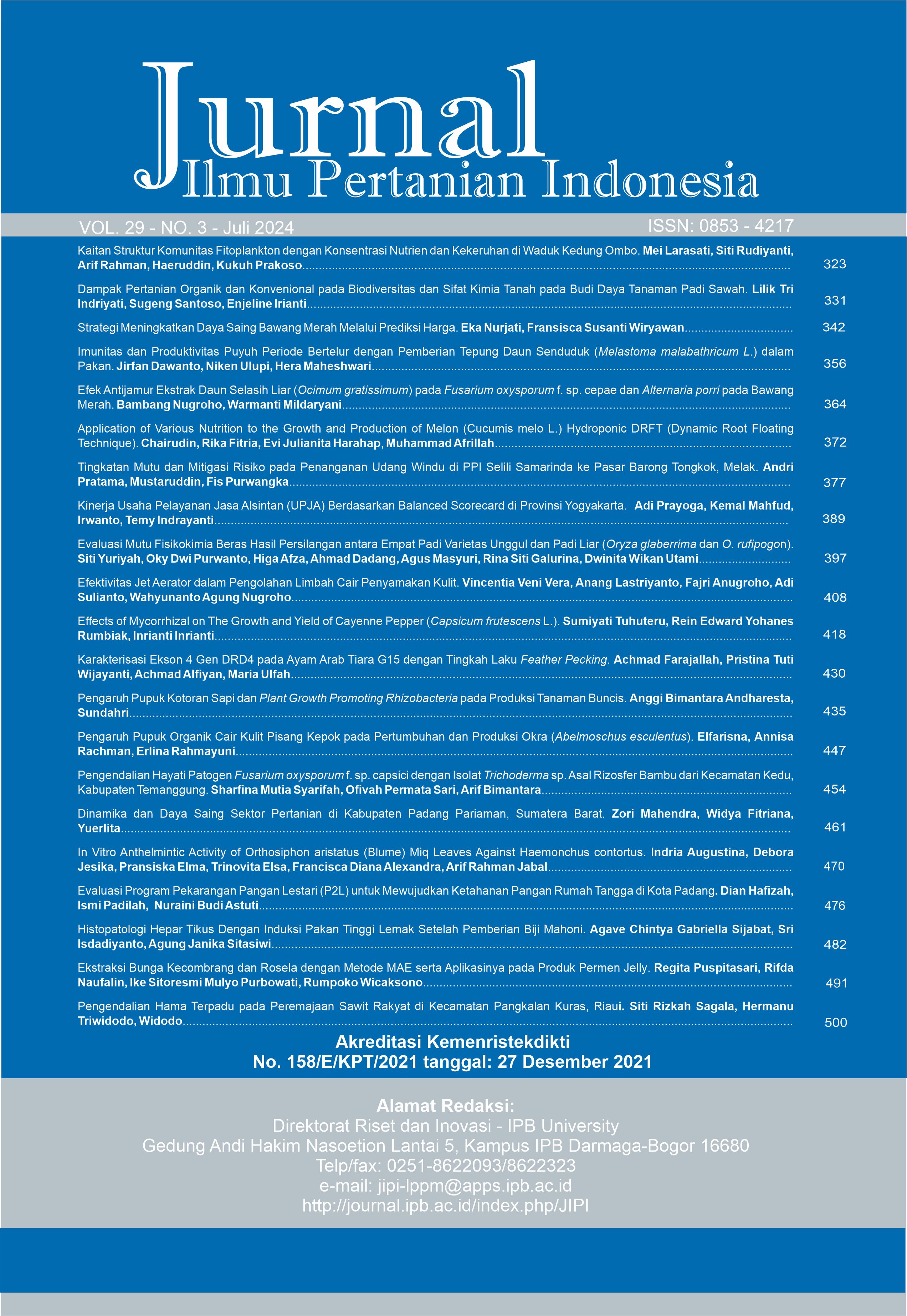In Vitro Anthelmintic Activity of Orthosiphon aristatus (Blume) Miq Leaves Against Haemonchus contortus
Abstract
Haemonchosis is an infection caused by the Haemonchus contortus worm, a blood-sucking gastrointestinal parasite that can also infect humans. Orthosiphon aristatus (Blume) Miq leaves have been shown to have anthelmintic activity due to the presence of saponins, flavonoids, and tannins. This study aimed to determine the anthelmintic activity of ethanol extract of Orthosiphon aristatus (Blume) Miq leaves against H. contortus. The infective H. contortus larvae were divided into six treatment groups: a 0.5% ethanol extract concentration group, a 1% ethanol extract concentration group, a 2% ethanol extract concentration group, a 4% ethanol extract concentration group, a positive control group (+), and a negative control group (-), each with four replicates. The study was conducted in six hours, with observations made at the 1st, 2nd, 4th, and 6th hours. The results showed that the death of the larvae increased with higher ethanol extract concentrations and longer exposure to the ethanol extract of Orthosiphon aristatus (Blume) Miq leaves. The time of death for infective H. contortus larvae given the ethanol extract of Orthosiphon aristatus (Blume) Miq leaves was at the 4th hour, and the effective dose of the ethanol extract as an anthelmintic was at the concentration of 0.5%.
Keywords: Anthelmintic, Haemonchus contortus, Orthosiphon aristatus
Downloads
References
Ghadirian E, Arfaa F. 1973. First report of human infection with Haemonchus contortus, Ostertagia ostertagi, and Marshallagia marshalli (family trichostrongylidae) in Iran. J Parasitol. 59(6): 1144–5. https://doi.org/10.2307/3278661
Hadi RF, Handayanta E, Widyawati SD, Hanifa A, Suprayogi WPS, Sudiyono A. 2021. In vitro anthelmintic activities of shrub plants extracts for Haemonchus contortus worms. IOP Conf Ser Earth Environ Sci. 712(1). https://doi.org/10.1088/1755-1315/712/1/012047
Hai NT, Van Thanh N, Tho BT, Atsushi M. 2014. A study about anthelmintic effect of Punica Gramatum L bark on veterinary endoparasites. Asian J Pharm Clin Res. 7(2): 148–152.
Kuntari T. 2008. Daya Antihelmintik Air Rebusan Daun Ketepeng (Cassia alata L) terhadap Cacing Tambang Anjing in vitro. Logika. 5(1): 23–26. https://doi.org/10.20885/logika.vol5.iss1.art1
Kristianto W, Hayati R, Ishak NI. 2020. Faktor – Factors Associated with the Incidence of Worms in Children Aged 7-10 Years in the Working Area of UPT Barimba Health Center, Kapuas Hilir District, Kapuas Regency in. [thesis]. Banjarmasin (ID): Universitas Islam Kalimantan Muhammad Arsyad Al-Banjari Banjarmasin.
Lem M, Pone J, Vincent K, Joseph T. 2012. Prevalence and intensity of gastro-intestinal helminths in horses in the Sudano-Guinean climatic zone of Cameroon. Trop Parasitol. 2(1): 45. https://doi.org/10.4103/2229-5070.97239
Naeem M, Iqbal Z, Roohi N. 2021. Ovine haemonchosis: a review. Trop Anim Health Prod. 53(1): 1–5. https://doi.org/10.1007/s11250-020-02439-8
Maestrini M, Tava A, Mancini S, Tedesco D, Perrucci S. 2020. In vitro anthelmintic activity of Saponins from Medicago spp. against sheep gastrointestinal nematodes. Molecules. 25(2): 1–9. https://doi.org/10.3390/molecules25020242
Minister of Health of the Republic of Indonesia. Deworming. Jakarta: Regulation of the Minister of Health of the Republic of Indonesia. 2017. p. 1–49. (Indonesia)
Muda I, Prastowo J, Nurcahyo W, Sarmin S. 2021. Anthelmintic effect of Indigofera tinctoria L on Haemonchus contortus obtained from sheep in Indonesia. Vet World. 14(5): 1272–8. https://doi.org/10.14202/vetworld.2021.1272-1278
Rahmadani F, Hastuti S. 2020. Uji Toksisitas Ekstrak Etanol Batang Petai Cina (Leucaena leucochepala) Terhadap Cacing Gelang Ayam (Ascaridia galli). J Ilmu Farm. 11(1): 28–34. https://doi.org/10.61902/cerata.v11i1.97
Sujith S, Sreedevi R, Priya MN, Deepa CK, Darsana U, Sreeshitha SG, et al. 2015. Anthelmintic activity of three Indian medicinal plants. Int J Pharmacogn Phytochem Res. 7(2): 361–4.
Sultana Y, Kong F, Mukutmoni M, Fahria L, Begum A, Lee R. 2022. Internal transcribed spacer region 1 as a promising target for detection of intra-specific polymorphisms for Strongyloides stercoralis. Trop Parasitol. 12(1): 48. https://doi.org/10.4103/tp.tp_13_21
Swargiary A, Daimari A, Daimari M, Basumatary N, Narzary E. 2016. Phytochemicals, antioxidant, and anthelmintic activity of selected traditional wild edible plants of lower Assam. Indian J Pharmacol. 48(4): 418–423. https://doi.org/10.4103/0253-7613.186212
Ulya N, Endharti A tri, Setyohadi R. 2014. Testing of the Anthelmintic Ethanol Extract of Kumis Kucing Leaves (Orthosiphon aristatus) as an anthelmintic against Ascaris suum in vitro. Maj Kesehat FKUB [Indonesia]. 1: 130–136.
Widiarso BP, Kurniasih K, Prastowo J, Nurcahyo W. 2018. Morphology and morphometry of Haemonchus contortus exposed to Gigantochloa apus crude aqueous extract. Vet World. 11(7): 921–5. https://doi.org/10.14202/vetworld.2018.921-925
Williams AR, Fryganas C, Ramsay A, Mueller-Harvey I, Thamsborg SM. 2014. Direct anthelmintic effects of condensed tannins from diverse plant sources against Ascaris suum. PLoS One. 9(5). https://doi.org/10.1371/journal.pone.0097053
[WHO] World Health Organization. 2022. Soil-Transmitted Helminth Infections. Geneva :World Health Organization.
Zlotek U, Mikulska S, Nagajek M, Swieca M. 2016. The Effect of Different Solvents and Number of Extraction Steps on the Polyphenol Content and Antioksidant Capacity of Basil Leaves (Ocimum bassilicum L.) Extracs. Saudi Journal of Biological Sciences. 23(5): 628–633. https://doi.org/10.1016/j.sjbs.2015.08.002
Copyright (c) 2024 Arif Rahman Jabal, Indria Augustina, Trinovita Elsa, Francisca Diana Alexandra, Debora Jesika, Pransiska Elma

This work is licensed under a Creative Commons Attribution-NonCommercial 4.0 International License.
This journal is published under the terms of the Creative Commons Attribution-NonCommercial 4.0 International License. Authors who publish with this journal agree to the following terms: Authors retain copyright and grant the journal right of first publication with the work simultaneously licensed under a Creative Commons Attribution-NonCommercial 4.0 International License. Attribution — You must give appropriate credit, provide a link to the license, and indicate if changes were made. You may do so in any reasonable manner, but not in any way that suggests the licensor endorses you or your use. NonCommercial — You may not use the material for commercial purposes.























